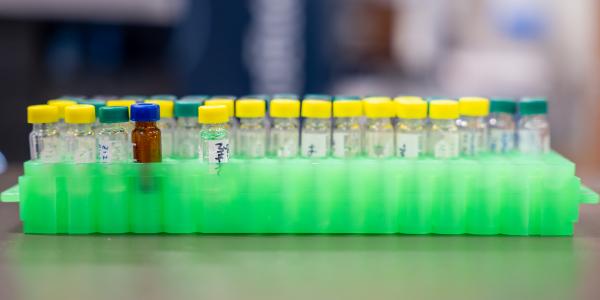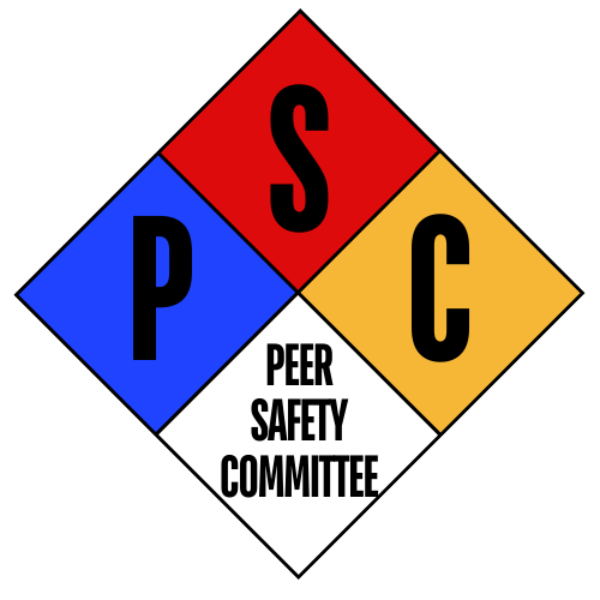Gary Patti takes a leading role in a $50 million project to study environmental chemicals and other threats to human health.
Gary Patti is quick to warn visitors about the untested, potentially hazardous chemicals in his office in Bryan Hall. He doesn’t have any bubbling beakers or glowing test tubes, but there’s a quart-sized bottle of hand sanitizer on his desk. “We encounter tens of thousands of chemicals every day, even in products like hand sanitizer and shampoo. The overwhelming majority of chemicals have never been tested for safety.”
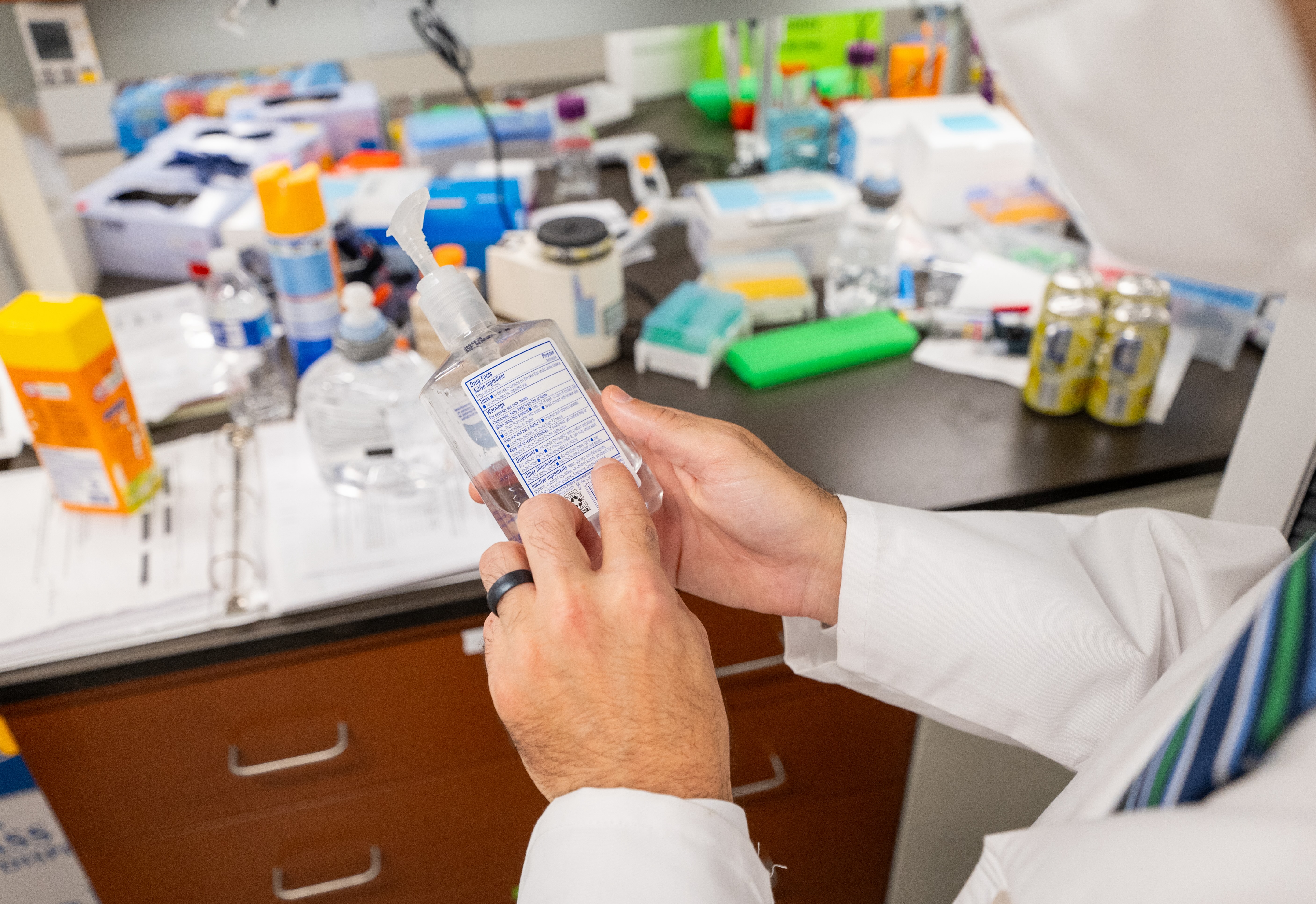
In the case of hand sanitizer, the benefits of killing viruses and bacteria very likely outweigh the risks of chemical exposure — that’s why his container is half empty. But that pump bottle still underscores a valuable point: Chemicals are everywhere, and what we eat, drink, breathe, or rub on our hands might matter more than we realize.
“People blindly expose themselves to all sorts of substances without a second thought,” Patti said. “Those exposures could be a big reason why some people develop cancer and other diseases.”
Instead of simply worrying about chemical exposure — he does plenty of that in his own time — the Michael and Tana Powell Professor of Chemistry is looking for answers. As a principal investigator of a five-year, $50 million National Institutes of Health (NIH) project, he will collaborate with researchers across the United States to address one of the fundamental mysteries of human health: Why, exactly, do some people develop serious diseases while others stay relatively healthy?
The project, which includes about $20 million for WashU, will convene a consortium of 53 scientists to break down the fundamental causes of disease, including the potential role of environmental chemicals. WashU will serve as the hub for the project, a role that solidifies the university’s status as a leader in multidisciplinary research into human disease. “What we're doing here is relevant to all of health and disease,” Patti said.
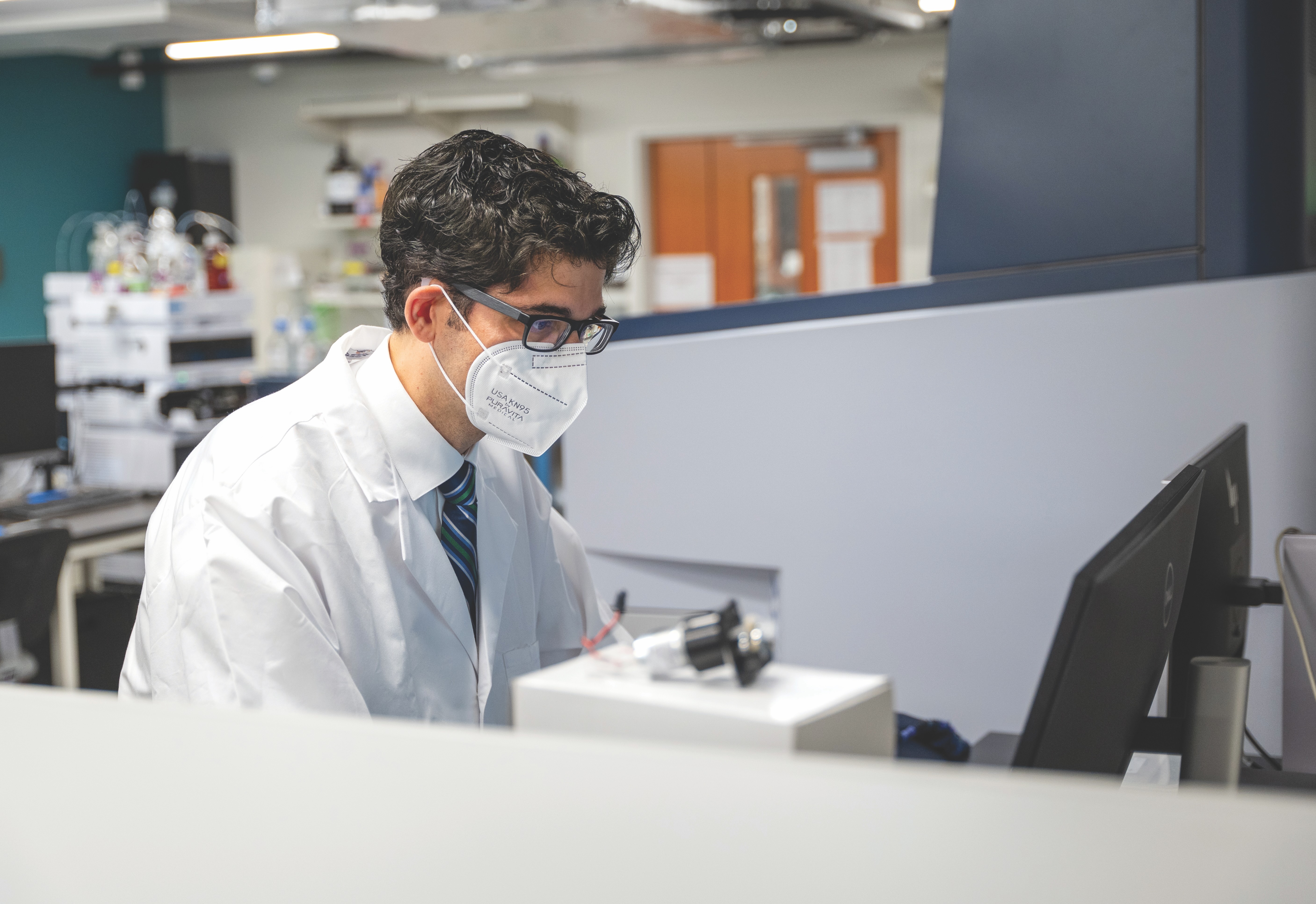
Uniting the “omics” of health
Led by researchers at WashU, the consortium will study blood and tissue samples from about 1,800 people representing a range of ages, ethnicities, and regions of the country. Each of the sites collecting patient samples will focus on a specific population and health condition, including diabetes, chronic kidney disease, asthma, preeclampsia, and steatotic liver disease.
Using mass spectrometry and other technologies, researchers will gather data on nearly every vital component of a living cell. The investigation will include genomics (the study of genes), metabolomics (the study of compounds involved in metabolism), and proteomics (the study of proteins). This “multi-omic” approach allows researchers to make the most of modern technologies.
In a first for an investigation of this size, the NIH project will also include the “omics” of environmental exposure, or exposomics. Patti hopes the study will elevate the science of the exposome and firmly establish the role that environmental chemicals can play in human health.
“Each of the omics captures different types of information,” said Leah Shriver, a research associate professor of chemistry involved in the NIH project. “When you put them all together, you should get a comprehensive picture of what's going on in a disease process.”
The WashU team offers unique expertise in each of the omics. The genomics side is headed by Ting Wang, the Sanford C. and Karen P. Loewentheil Distinguished Professor of Medicine and head of the Department of Genetics at the School of Medicine. Wang, a co-leader and principal investigator of the project, is a recognized expert in the study of epigenetics, the factors other than DNA that can affect gene expression. His work continues a decades-long tradition of genomic breakthroughs at WashU.
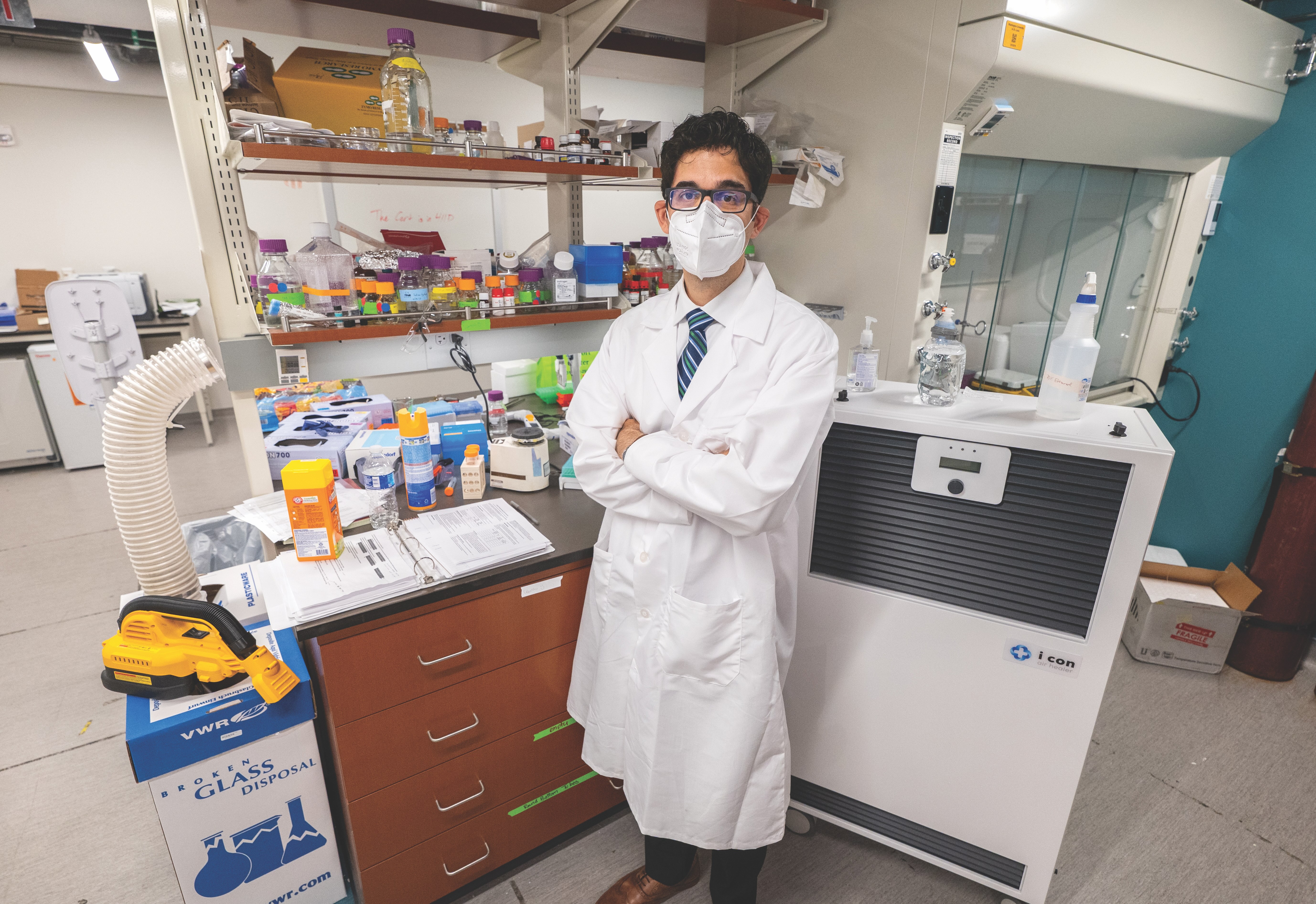
In the early 2000s, the McDonnell Genome Institute played a key role in developing the first map of the human genome. Less than a decade later, WashU became the first institution in the world to sequence the entire genome of a cancer patient, a pioneering effort to understand the genetic component of a disease. “The combination of our genomic expertise and Gary’s expertise with the other omics makes us second to none,” Wang said.
While genes can play a huge role in triggering disease, DNA is rarely a full explanation for an illness, Patti explained. For example, up to 70% of women who inherit the genetic mutation BRCA1 will develop breast cancer by their 70s. That’s a terrible toll, Patti noted, but it’s well short of 100%. It’s possible, perhaps even likely, that women with that mutation will develop cancer only if they are exposed to high levels of certain chemicals over their lifetimes, he said.
A critical piece of the NIH project involves outreach to populations overlooked in past studies. The six disease centers involved with recruiting study subjects have pledged that at least 75% of participants will come from historically underrepresented populations in genomics research, including Hispanics and African Americans. Such diversity will be crucial for understanding the role genes play in disease, Wang said. Past genome projects have often focused on small numbers of mostly white people, he said. “It’s no longer one-genome-fits-all.”
Supercharged blood panels
Patti’s gleaming, hyper-clean mass spectrometry lab hums with more than 20 high-tech instruments, a concentration of detecting power rarely found outside massive government laboratories. The instruments will allow him to identify and quantify individual molecules in patient samples — something like a supercharged version of a blood panel test at a hospital.
Blood panel tests typically measure things like cholesterol and blood sugar, but the vast majority of compounds in our blood go untested, Patti said. “Standard panels are much smaller than the tip of the iceberg,” he said. “We’re attempting to measure thousands or tens of thousands of molecules at once.”
Mass spectrometers work by using high voltage to create gas ions from whatever sample is being tested. The ionized gas particles then travel inside the instrument, where their masses are measured. The unique mass signature of each molecule makes it possible not only to identify just about any chemical in a sample but also to quantify its relative amount. Patti, who won the Biemann Medal from the American Society for Mass Spectrometry for his pioneering work in the field of metabolic research, said tracking tiny molecules can be pivotal for getting a big-picture view of a disease.
The technology can be used in multiple ways to answer key questions about disease. To better understand the chemicals that make up the exposome, for example, the team will search for potentially hazardous substances such as PFAS, or “forever chemicals.” Found in everything from nonstick cookware to stain-resistant clothing to tap water, PFAS are suspected to negatively affect the immune system, metabolism, and other aspects of human health. Researchers can also mine the data to find signs of unexpected or unknown compounds that could profoundly impact health.
Measurements gathered by Patti and his team of postdocs and graduate students will create a massive database that should offer unprecedented insights into the roots of disease. Then, other members of the NIH consortium will conduct statistical analysis to determine if certain compounds are associated with a specific health condition. Researchers may not be able to draw a straight line between any one environmental exposure and illness, Patti said, but a closer look at the data should show how chemicals fit into a complicated picture that includes a person’s genes and lifestyle.

A new era in precision health
Downstairs from his lab of top-of-the-line mass spectrometry equipment, Patti keeps another lab featuring relatively low-tech fish tanks teeming with thousands of tiny, stripy zebrafish, another extension of his intense interest in the link between environmental exposures and disease. In his zebrafish lab, fish zip around in dozens of small tanks, where they live on precisely controlled diets. Fish in one tank feast on a high-fat diet while their neighbors in the next tank go lean. Other tanks are labeled “PFAS,” signifying these animals are getting dosed with forever chemicals. Look closely and you can see some fish are swimming around with small, dark tumors, a sign that their assigned diet and chemical exposures aren’t ideal for health.
Those zebrafish aren’t just research animals — they’re a direct connection to Patti's early days at WashU and to his mentor, Stephen L. Johnson, a professor of genetics and renowned zebrafish geneticist who died in 2017 at the age of 56. To this day, Johnson’s portrait hangs on the door to Patti’s zebrafish lab, a testament to his mentorship and legacy.
Whether he’s studying zebrafish or cancer patients, Patti is focused on finding the factors that really matter to health. Medical care and wellness advice too often follow a one-size-fits-all model, Patti said. Take the instructions on a bottle of aspirin, he said. “It’s the same directions for an adult who’s 350 pounds and my twin sister, who is 100 pounds. Because we’re all unique, we should receive unique care,” he said.
Zeroing in on critical markers will allow for advances in precision medicine, a tailor-made approach to treatment and prevention that aims to give each person their best chance at optimal health. Insights from the NIH project and similar studies could guide treatments and help people make important life decisions, Patti said. “If your genes make you especially susceptible to chemicals that are abundant in one part of the country, perhaps you would decide to live somewhere else,” he said.
The results of the NIH project are still several years away, but Patti doesn’t want to take unnecessary chances. After spending much of his career studying environmental causes of illness, he wants to limit his exposure to everyday chemicals as much as possible. His home is equipped with an anti-radon device, reverse osmosis water filters, and lots of unprocessed organic foods. “It’s a good practice to review the chemical composition of food, cosmetics, cookware, and clothing,” he said. “We should always be thinking about what we’re putting into our bodies.”
Patti recognizes that a lot is riding on this project. Not only is he attempting to give everyone the information they need to stay healthy, but he’s also aiming to prove that massive multi-omics projects have a place in science. “That’s a lot of responsibility,” he said. “I am both professionally and personally committed to doing whatever it takes to ensure we are as successful as possible. The future of multi-omics could depend on it.”

